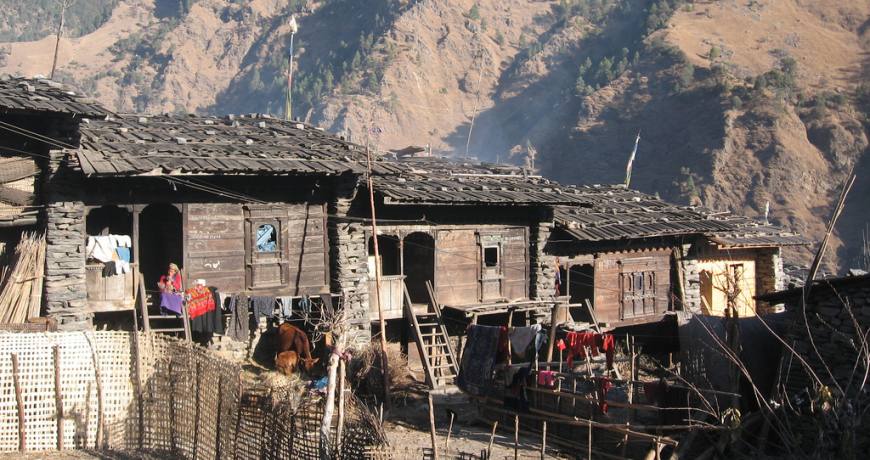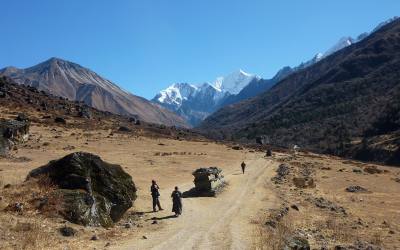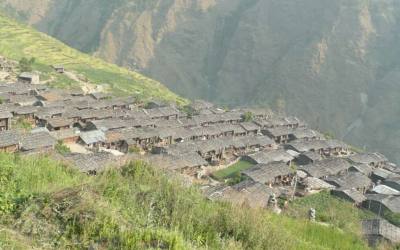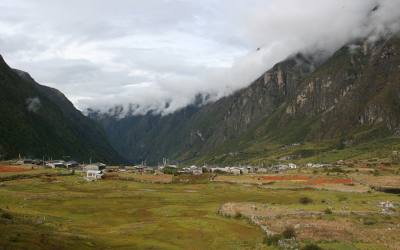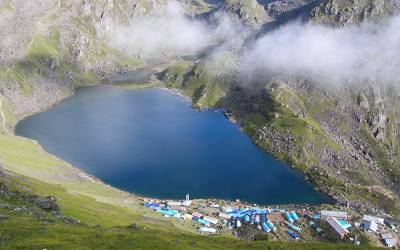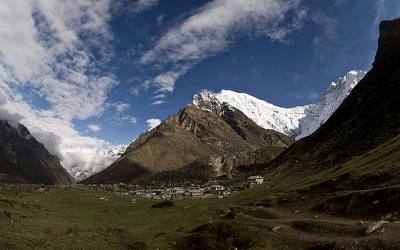Rasuwa district, situated at about 120-km north (32 nautical miles) of the capital city Kathmandu has a total area of 1544 sq.km. The altitudinal variation ranges from 845 (Betrabati) alms to 7245m (Langtang Lirung). The district is accessed with the 118 km long Pasang Lamu highway from Kathmandu. Rasuwa is the homeland of various ethnic groups and caste. The majority of the groups is dominated by Tamang (64%) followed by Brahmins (16%), Gurungs (7%), and so on. Rasuwa is rich equally in natural and cultural resources. Tourism has been emerged as the second most viable economic sector aafter agriculture (DPP 2002 Rasuwa). Rasuwa constitutes major parts of Langtang area. Langtang is a popular tourism destination as well as a beautiful geographical landscape representing important part of Rasuwa, Sindhupalchok and Nuwakot districts. This area has been managed as Langtang National Park since 1976. The prime tourism resources and geographical area of the Park fall in Rasuwa district representing 974.5 sqkm out of 1710 sq km area of National Park. Langtang is the third most popular trekking destination after Annapurna and Everest region. Trekking tourism was started here in 1979 and has reached a maximum number about 13000 in 2000. It absorbs about 10% of the trekkers coming to Nepal. Around 20000 pilgrimages also visit Goshaikunda each year. The trekking tourism in Langtang follows distinct seasonally and the busiest seasons are Oct-Nov and March-April (60%).
Major tourism resources
A visit to Langtang offers the kaleidoscopic insight of scenic landscape, magnificent nature and unique Tamang culture to the visitors within a few days trek from the capital City kathmandu. The combination of natural and cultural resources has added the value of tourism potentiality in Langtang and has placed Langtang as destination for many reasons. The tourism resource of Rasuwa is broadly described under natural and cultural resources.
Natural resources: The landscape of Rasuwa is extremely dissected and much of the area comprises glacio-fluvial, collivial and moraine deposits. The climatic conditions of the district range from sub tropical to arctic and this drastic variation of climate at a short distance has resulted the five broad categories of vegetation ranging from deciduous subtropical forests (Sal forest) to temperate, sub-alpine and alpine vegetation. Langtang area also comprises high level of biodiversity including 15 forest types, 3000 species of flowering plants, more than 10 species of Rhododendron, Orchids, Primulas etc. The important faunal species includes Musk Deer, Snow Leopard, Red Panda Himalayan Tahr, Himalayan Languor, Asamese Monkey, 46 species of mammals and more than 250 species of identified birds etc. The beautiful Mountain peaks including Langtang-Lirung (7245m) Sanjen and Ganesh Himal as well as the adventurous pass including Gonjala pass, Lauribina pass, Pangsang pass, Langmala pass are the prime attraction of adventurous tourism in Rasuwa. Likewise high altitude lakes including Goshaikunda, Parvatikunda, Riverkunda, Dudh kunda, Jageshwor kund etc are also the prominent tourism features of cultural and scenic importance. Kyanjin valley, Langtang valley, Sanjen valley, Nagthali, Tatopani hot water Spring are the other areas of natural attraction in the district. Cultural resources: Rasuwa district is equally rich in cultural heritages. Major cultural resources include Tamang culture, tradition, cultural sites and pilgrimage sites. Major area of cultural attraction are Gosaikunda, Langtang valley (a fusion of Tibetan and Tamang culture), Gutlang-Goljung areas (living heritage of Tamang culture and architecture), Kanjin and Sing Gomba (oldest Buddhist monasteries). The presence of historic fort Rasuwa Gadi with the boarder to Tibet and historical and religious site Betrabati are other additional site of socio-cultural value in Rasuwa district.
Major tourism Product of the district
The tourism product of Langtang is broadly classified into following 3 categories:
· Biodiversity experience
· Landscape experience
· Cultural experience
Despite the enormous tourism attractions, safety and the easy access from Kathmandu, the scenario of tourism growth in Langtang area has not followed the general trend as it has been in Annapurna and Everest regions. Current tourism trend is too much concentrated in some particular areas like Kanjin and Goshaikunda with too narrow scope of activities. Major principle market and tourism trend of the district Potential market segment of the area includes Organized group trekkers; adventure groups; special interest groups; mountaineers; free individual trekkers (FITs), pilgrims, domestic trekkers and cultural tourists. Of the total trekkers about 60% are free individual trekkers (FITs). The trekking tourism in Langtang follows distinct seasonally and the busiest seasons are Oct-Nov and March-April (60%). Also about 20000 pilgrimages visit Goshaikunda and about 3000 domestic tourist visits Tatopani for medical purposes.
Access to the area
The district is accessed with the Pasang Lamu Highway (Trishuli-Somdang road). 3 local bus and rented jeep are available for the visitors. However the access is not comfortable and reliable due to the heavy landslide at Ulkharka (before Dhunche) during rainy season. Private Helicopter charter service is also available from Kathmandu.
Major trekking routes in the district
There are mainly three trekking routes of having different tourism experiences in Rasuwa. Goshaikund trail (6-days) and Langtang trail (9- days) are the established trekking trails where as the Tamang Heritage Trail (8-days) is the newly developed trail offering the blends of cultural and natural experiences. Beside these trekking trails, a greater Langtang circuit trek (17-days) combining all three trails can be done in Rasuwa. Major features of these routes are described separately below.
Tourism trend since 25 years back
Overview of Tamang Heritage Trails
In order to materialize the rich Tamang culture and associated natural attractions as tourism product in the Tamang areas of Rasuwa, a new tourism product called Tamang Heritage Trail has been developed and promoted by DDC: TRPAP Rasuwa. The trail starts either from Dhunche or Syabrubesi and passing through Goljung, Gatlang, Chilime, Thuman, Timure and Briddim. The trail may ends at Briddim village or follows the Langtang trek from Briddim village via Khanjim. The trail follows the row of Chhorten (Buddhist shrines with a square base topped with an onion-shaped dome and Mani walls. Manis are prayer stones engraved with mantras) from Gatlang to Timure along the old traderoute to Tibet. Tamang Heritage Trail passes through the mountain villages where the traditional architecture, crafts and style of dress has remained unchanged.
The areas included in the trail have different tourism experience. Goljung and Gatlang villages are especially popular for their rich Tamang culture, architecture and lifestyle. Gatlang is especially famous for its houses of wooden roof, beautiful Gomba and beautifully embroidered hats and live craftsmanship. They are Buddhist by religion and they decorate their houses with the buddhist’s symbol. Prayer flags, prayer wheels, prayer walls are some of the decorational pieces.A viewpoint has been built at Bahundanda from where one can see the panoramic view of Langtang, Kerung, Ganesh Himal and Sanjen Himal range. Gatlang is blended with the presence of holy Lake Parvatikund. Gatlang is the largest Tamang settlement made up of stone wall and wooden roof. A visit to Gatlang village offers an experience of live Tamang museum. Traditionally women wear a colourful, wrapped skirt, blouse, a jacket and scarf. Men wear lain cloths or the traditional trouser(pants) short sleeved jacket and topis(cap) Tatopnai trail through Chilime VDC is famous for its popular natural hot water spring, possibly the biggest hot spring water in Nepal. The place get usually crowded with people from different part of Nepal coming there with the strong believed of getting heal from skin diseases and muscles ache. Nagthali,on the other hand offers the Kaleidoscopic view of Langtang, Kerung, Ganesh Himal and Sanjen Himal range. It is belived that Nagthali was the meditation centre of the ancient Great Tibetan Lamas. Thuman VDC is popular for the Tamang-Tibeto cultural and tradition which one can observe on the way to Timure. Timure is the old traderoute to Tibet which is famous for its historical fort of Rasuwa Gadhi lies on the bank of the popular river name Bhote Koshi means river from Tibet. It displays the scene of ancient battles between Nepal and Tibet. The next hub is Homestay village called Briddhim lies at the laps of Langtang Himal. One can experience the Tamang-Tibetan culture with the accommodation facilities at typical Tamang house. The stay at Briddim is managed by the Homestay management committee.
The new Tamang Heritage Trail, offers a peek at the Himalayan life-style and ulture.This itinerary takes you through verdant midlands of Nepal experiencing the beauty of this mountain region and the culture of the people who live here. The trail passes through traditional Tamang villages where life, culture, and crafts have remained unchanged since the beginning of the settlement. Warm traditional welcome hosted by the locals, their elaborate costumes, rich architecture of their mountain houses, and the ancient monasteries and places of pray add color to the experience of this trail. In addition to this, the trek also offers wilderness experience through beautiful landscapes of alpine terrain, flat meadows, and rhododendron forests.
The trail starts from Dhunche or Syabrubesi and passes through Goljung, Gatlang, Chilime, Thuman, Timure and Briddim. The trail may and back in Syabrubesi or follow the Langtang trek from Briddim village via Khamjim,Goljung and Gatlang are traditional Tamang villages. Goljung has as ancient monastery. From the viewpoint at Bahundanda near by one can see a panoramic view of Langtang ,Kerung and the Ganesh Himal,Sanjen Himal ranges, Gatlang set high on a hillside among terraces fields is a Tamang settlement.One can visit a Tamang monastery and the beautiful Parvatikunda lake at Gatlang,Bathing in the hot,healing waters of the natural spring at Tatopani en route from Gatlang to Chilime is an exhilarating experience. Bridim offers cultural experience at community-run homestay while Nagthali in Thuman VDC is surrounded by beautiful views of Himalayan ranges.
Langtang Valley
The Langtang Himal is a region north part of Kathmandu. vally and it lies just south of Tibetan border. The langtang valley is surrounded by high peaks of great appeal. It has become famous ever since the British mountaineer Bill Tilman described it as the most beautiful valley in the world. The highest peak in this area is Shisapangma or Gosaithan 8027m in Tibet. The course from the Langtang valley to Gosaikund is full of diversity and it is attracting many tourists. The langtang valley is also know as the treasure house of Alpine plants. The whole valley is cover with flowers during the summer.
This high and isolated region is inhabited by Tamangs whose religious practices, language and dress are much more similar to Tibetan
Flora and Fauna
The forests of Helambhu region and Langtang area is prime example of temperate and sub alpine vegetation. The dense oak and pine forests on the trail are of particular interest. During the spring Rhododendrons are also very spectacular.
People and culture
The people here, are of Tibetan origin and call themselves sherpa although they are quite distinct from the sherpas of Everest region both in language and customs. Many Tamang people also inhabit this area, Tamangs are also orginated in Tibet but settled in Nepal considerably earlier than Sherpas.
Day01: Arrival and transfer to Hotel in kathmandu.
Day02: Free day in Kathmandu ( Kathmandu Durbar square and Swyambhu nath, Boudhanath stupa, Pasupatinath temple, Patan Durbar square)
Day03: By local bus or by private jeep to Syaprubesi village (1510m),8- 9 hours of driving. the private jeep will cost extra US$ 160.00 for one way
Day04: Trek to Gotlang village (2240m) 5-6 hrs of trek
Day05: Trek to Tatopani ( Hot spring)(2610m) 5-6 hrs of trek
Day06: Trek to Nagthali village (3150m) 6 hrs of trek
Day07: Trek to Bridim village (2230m) 6 hrs of trek
Day08: Trek to Sherpagoau village (2570m) 6 hrs of trek
Day09: Trek to Thangshep village (3140m) or to Langtang village (3305m) 6-7 hrs of trek
Day10: Trek to Khanjing Gompa (3830m) 4 hrs of trek at the afternoon visiting to Khanjingri (4100m)
Day11: explore around (to Tsercori peak 5030 m) 7-8 hrs of trek
Day12: Side trip to Langsisha Kharka (4100m) and return back to Khanjing Gompa.
Day13: Trek to Lama Hotel(2300m) 6-7 hrs of trek
Day14: Trek to Thulo syabru village (2210m) 7 hrs of trek
Day15: Trek to Sing Gompa Moansery (3330m) 5-6 hrs of trek
Day16: Trek to Gosaikund Lake (Sacred Lake)( 4260m) 5 hrs of trek
Day17: Trek to Ghopte village( crossing Lauribinayak Pass 4607m) 7-8 hrs of trek
Day18: Trek to Kutumsang village (2470m) 6-7 hrs of trek
Day19: Trek to Chisopani village (2220m) 6-7 hrs of trek
Day20: Trek to Sundarijal then by private transport to Kathmandu (4 hrs of trek and 1 hour of Driving)
Day21: Tour Ends (Departure)
Day 01: Arrival and transfer to Hotel in Kathmandu
Upon arrival in Kathmandu. Our airport representative will be waiting outside the airport terminal a few metres from the exit door. Please check your name at play card. He will bring you to hotel in kathmandu. The drive from the airport to the hotel is around 20 minutes.
Day02: Free day in Kathmandu or self sight seeing around kathmandu valley (option are)
Mount Everest flight
It is possible to book a flight to see Mount Everest whilst you are in Kathmandu. The cost is US$190.00 (subject to change) per person .
The one hour Everest flight takes off from Kathmandu Airport and flies east where you can see magnificent mountains, including Mount Everest, from a height of around 25,000 feet. You can enjoy a seemingly endless chain of snow capped peaks as you fly above the clouds, over glaciers and lakes, rivers and gorges from your private individual window. This excursion offers a great opportunity to experience and photograph the aerial view of the highest mountain peaks in the world, the Kathmandu valley and the landscapes of Nepal.
Hanumandhoka (Kathamdnu Durbar Square):
It is the historic seat of royalty. The Durbar Square, with its old temples and palaces, epitomizes the religious and cultural life of people. It is here that kings of Nepal are crowned and their coronations solemnized. Interesting things to see here are, Taleju temple built by king Mahendra Malla in 1954 AD, the temple of Kal Bhairab , the god of destruction, Nautale durbar, the statue of King Pratap Malla, the big drum and the Jaganath temple. It was listed in the UNESCO world heritage monument list in 1979.On the right hand corner, a large wooden lattice screen hides an enormous gilded face of Sweta Bhairab. The screen is removed only during the Indra Jatra festival.. there are also the Numismatic museum and Tribhuban museum inside the Hanuman Dhoka palace building . Photography is prohibited inside the museums. Both the mseums remain closed on Tuesday and government holidays.
Swoyambunath Temple( Monkey Temple)
The famous Swayambunath Temple is perched on a hill outside Kathmandu and has a square golden stupa rising from a lovely white dome. Monkeys play on the steps up to this temple. Swayambhunath is said to be more than 2000 years old and is a very holy place for Buddhists as well as Hindus. You have a wonderful view over Kathmandu from here.
Boudhanath stupa is the largest stupa in Nepal and the holiest Tibetan Buddhist temple outside Tibet. It is the center of Tibetan culture in Kathmandu and rich in Buddhist symbolism. The stupa is located in the town of Boudha, on the eastern outskirts of Kathmandu.
History:
Bodnath was probably built in the 14th century after the Mughal invasions; various interesting legends are told regarding the reasons for its construction. After the arrival of thousands of Tibetans following the 1959 Chinese invasion, the temple has become one of the most important centers of Tibetan Buddhism. Today it remains an important place of pilgrimage and meditation for Tibetan Buddhists and local Nepalis, as well as a popular tourist site.
Pashupatinath Temple:
Situated 5km east of kathamandu, the temple of Lord Shiva, Pashupatinath, with two tired golden roof and silver door is considered one of the holiest for Hindus. Although only Hindus are allowed inside the temple, visitors can clearly see the temple and the activites performed in the Temple premises from the eastern bank of the Bagmati river. The Temple was listed in the UNESCO world heritage Monument List in 1979
Patan :
The ancient city of Patan, lying 5 km southwest of kathmandu, is known as the city of fine arts, The city is full of Hindu temples and Buddhist monuments. The diversity of the medieval culture that allowed both Hinduism and Buddhism to flourish has left a rich legacy of impressive sightseeing in this city for today’s visitors.
Patan Durbar Square
Situated in the heart of the city, constitutes the focus of visitor’s attraction. The square is full of ancient palaces, Temple and shrines, noted for their exquisite carvings. The Patan durbar Square consist of three main chowks or countryards, the Central Mul Chowk, Sundari Chowk and Keshar narayan Chowk, The Sundari Chowk holds in its center a masterpiece of stone architecture. The Royal Bath called Tushahity. It was listed in the UNESCO world Heritage Monument list in 1979.
Day03: Kathmandu- Dhunche(1960m)- Syabrubesi.(1458 mts) 8-9 hours (Driving). Syabrubesi (Hotel/ lodges). Dhunche is center of this region. Where it has all the govt offices and a small bazaar.
You are heading north out of Kathmandu driving through scenic foothills and ridgeline vistas to Dhunche or Syaprubesi. While passing along the road on the bank of the Trishuli River you catch a glimpse of Ganesh Himal, terraces and green hills
Day 04: Syabrubesi – Bahundada(1919m) – Gatlang(2238m). 5-6 hrs (Trekking). Gatlang (Community Lodge).
Till to the Tea break at Bahundada is all the going uphill which is hard takes around 2.30 hrs and after that it is easy walking around 3 hours on motarable trails to reach the beautiful Tamang village called Gatlang which is the place for our camp that is community lodge and the lunch . A viewpoint has been built at Bahundanda from where one can see the panoramic view of Langtang, Kerung, Ganesh Himal and Sanjen Himal range and also different villages of Goljung and Chilime . Gatlang is blended with the presence of holy Lake Parvatikund that lies around 2550m. Gatlang is the largest Tamang settlement made up of stone wall and wooden roof. A visit to Gatlang village offers an experience of liveTamang museum. Gatlang villages are especially popular for their rich Tamang culture,architecture and lifestyle. Gatlang is especially famous for its houses of
wooden roof, beautiful Gomba and beautifully embroidered hats and live craftsmanship. They are Buddhist by religion and they decorate their houses with the buddhist’s symbol. Prayer flags, prayer wheels, prayer walls are some of the decorational pieces
Day 05: Gatlang – Tatopani(2607m). 5-6 hrs (Trekking). Tatopani (Lodge).
1.30 hrs is easy going down the mix trails that is gradually down hill and slopes till to reach the tea break at chilime which is around 1762m. After that it will be going up hill which is bit hard to reach the lunch break at Gonggang which is around 2227m. After that it will be gradually going up to the camp.One the way one can view beautiful landscapes and rock mountains with tiny village down the hill and to the opposite hill. Tatopnai trail through Chilime VDC is famous for its popular natural hot water
spring, possibly the biggest hot spring water in Nepal. The place get usually crowded with people from different part of Nepal coming there with the strong believed of getting heal from skin diseases and muscles ache
Day 06: Tatopani – Nagthali(3165m) 4 hrs (Trekking). Nagthali (lodge).
This will be the short camp comparatively to the other will be easy walking through the jungle except some part till to reach the Tea break at Brimdang which is around 2848m and takes 2.15 hrs time. It is a small village of Tamang and can also observe the small monastery out there. After that small tea break it will be all the way going up the hill which is hard reaching to the top of the hill where the camp is situated and that takes around 1.15 hrs . Nagthali,on the other hand offers the Kaleidoscopic view of Langtang, Kerung,Ganesh Himal and Sanjen Himal range. It is belived that Nagthali was the meditation centre of the ancient Great Tibetan Lamas. It is always worthwhile to reach to that point which is offcourse the highest point of the trails.
Day 07: Nagthali – Thuman(2390m) – Bridim(2229m). 6 hrs (Trekking). Bridim (Homestay).
It will all the way going steppy down the hill through the small village name Thuman where there will be the stop for the Tea break and that takes around 2hrs. Thuman VDC is popular for the Tamang-Tibeto cultural and tradition which one can observe on the way. After the short break it is again going steepy down the hill to reach the river called Bhotekoshi which means river from Tibet takes around 2 hrs for the lunch break at the place name Lingling that is situated around 1737m. Then need to get ready for sweating to ascend the hill(uphill-hard) which takes around 2hrs to reach the beautiful home stay village. This hub is popular for its Homestay village that lies at the laps of Langtang Himal. and One can surely experience the Tamang-Tibetan culture with the accommodation facilities at typical Tamang house. The stay at Briddim is managed by the Homestay management committee.
Day 08: Briddim- Sherpagau(2563m) 5 hrs (trekking). Sherpagoau (lodge).
The trails follow the easy gradually going up through the jungle where one can see different birds an including the National bird called Danfe and different animals like deer till to the next spot for the tea break at Khanjim which lies around 2235m and that takes around 2 hrs. and can observe the beautiful hills having some drink break in this small village. And then walking around 3 hrs that is 1 hrs medium hard up hills and 2 hrs in an easy mix trails landed to the camp where one can enjoy the beautiful of landscapes and its peaceful surroundings.
Day 09: Sherpagau- Lama Hotel to Thangshep village or to Langtang village 6-7 hrs (Trekking). 3000 m.
After some 20 mins easy walking follow the down hill to reach the Langtang River for tea break at Bamboo which is around 1970 m takes around 2.30 hrs to reach the place via Rimche 2455 m which is common point that separated the way to the Langtang trekking too. From here trek another haif an hour to reach Lama Hotel. From here trail ascent through rhododendendron forest and walking through bank of Langtang khola. To reach place called River side. From where one can have good views of river and forest. Here we will break for lunch. After lunch trail become easier and wider till Ghoda Tabela . views of Langtang Lirung can be seen along the way . Where we will stay to night.
Day 10: Thangshep village to Khanjing Gompa 4 hrs ( Trekking) 3800 m at the afternoon climbing to Khanjingri (4100m)
After Ghoda Tabela you will walk through a Rhododendron forest and to the bank of Langlang Khola.. the ground covered by moss. Trees have ferns and epiphytic orchids on them. It looks like semi tropical jungle. After walking of 3 hours you will reach to Langtang valley. Where are big settlement of mix Tamang and Tibetain people. There are close views of Langtang lirung ,Ganjala and Naya khangga. Here we will break for Lunch. After lunch we climb up the road with stone walls and you will come to Chorten of Mani stones .you will see that Langtang Khola gets closer all the time and the valley becomes more open and wider.climb up the rocky moraine ahead and you will reach Khayanjing Gompa.
Day11: Rest day or climbing to Tsercori(5033m)
Khayanjing Gompa is the last permanent settlement with a small Gompa and a cheese factory. Use it as a base for day hikes, exploring the upper valley try to climbing the small hill north of Khayanjing or Tsergori(5033m). which lies upvalley from Khayanjing. Upper valley is ringed by spectacular snow peaks including fluted peak Langtang Lirung and the Tibetan named Dorje Lakpa
Day12: Side trip to Langsisha Kharka (4100m) and return back to Khanjing Gompa.
This is a good long walk that takes you all the way up the valley to where the Salbachum, Lanshisha Kharka, and Langtang glacial moraines all converge. To get there you just continue on the trail heading east out of Kyanjin Gompa. You'll follow the valley past the turn off to Tsergo Ri and past the air field. During the walk you only gain about one thousand feet over five or so miles. Round trip this can take the better part of a day so it's best to pack some lunch and bring some water with you,
Along the way you get some great views of the nearby peaks including Dorje Lakpa, and eventually Shisha Pangma, the only 8,000 meter peak in Tibet. During summer and early fall many yaks are still up in the high pastures.
Day13: Khanjing Gompa to Lama Hotel ( 2400 m) 6 to 7 hours of Trek
From Kyangjin you retrace your route, following the Langtang Khola to Langtang village and on to Ghora Tabela. After lunch, you continue the steep descent to Lama Hotel.
Day14: Lama hotel to Thulo Syabru village(2250m) ( 6 hour of trekking)
You continue retracing your steps some of the way to Thulo Syabru, but then branch left ascending a steep path through forests to suddenly emerge with a view of Syabru and its extensive area of millet terraces. An undulating path brings you to this fascinating village where each house is set above its neighbor, in a long line up the very crest of the ridge. It’s a great place to wander about, catching glimpses of Tamang life, admiring the beautifully carved wooden windows or simply relaxing in the sun.
Day15: Thulo Syabru to Sing Gompa 3350m. ( 5 hrs) Buddhist Monastery
From Thulo Syabru it is a steep climb through forests of oak, fir and rhododendron to the top of a ridge. From here it is only a short descent to Sing Gompa. There is a Buddhist monastery and a small cheese factory .
Day16 : Sing Gompa to Gosaikund Lake(4260m) Sacred lake
From here the path gently ascends the mountain flank with bare trees. After crossing the ridge . you will be going through a forest full of moss and fern. While you reach to Lauribinayak there is a spectacular views of Dhaulagiri, Annapurna, Ganesh Himal and Langtang Lirung. The best view point for entire trek. Crossing over the ridge of Saraswati Kund apper the first of several Lakes dedicated to different divinities. Gosaikund is the third lake, sacred place of Hindus and Buddhist.
Day 17: Gosaikund to Ghopte(3300m) via Lauribinayak pass (4607m).7 hrs of trek
After crossing the Lauribinayak pass(4610m) trail descends through stone path and forest to reach Ghopte.
Day18 : Ghope to Kutumsang (2400m) 6-7 hrs of trek.
From here trail continues ups and down through forest and walking in ridge of hill. You can have a good view of Helambu and Tadhi Valley.
Day 19: Kutumsang to Chisopani (2150m) 6-7 hrs of trek
Trail descends all the way to Patibhanjang. From here climb uphill for 2hours to reach chisopani. In a good day you can have a another spectacular views of mountain from Annapurna range to Everest.
Day 20: Chisopani to Sundarijal by trek then by private transport to Kathmandu.
After chisopani trail goes uphill for one hour till Bhanjang through forest. From Bhanjang trail descends all the way to Sundarijal via forest and several villages along the way. Bus ride will take about one hour from sundarijal to Kathamdnu.
Day21 : Tour Ends ( Departure)
Price Per Person US$ 675.00 (Price are based on standard class hotel)
Price for meals and drinks during the trek Allow US$ 22-24 per person per day for trekking (off-course you are going to pay every day directly by yourself to the tea houses during the trek.it is just a guideline)
Single supplement US$ 150.00 per person ( you will get single room in kathmandu and during the trek. you can book your trekking tour as a solo with us. in this case we will charge little higher)
Additional night in kathmandu will cost US$ 35.00 for Double room with Bed and Breakfast and US$ 30.00 for single room.
Trekking prices with out hotel in kathmandu will cost US$ 600.00 per person.
Off-course it is always possible to upgrade the hotel in kathmandu according to your budget and interest. But it will cost you extra and you need to pay the differences.
Hotel we use in this tour
Kathmandu Prince Hotel (standard class hotel)
Thamel, Chhetrapati, kathmandu, Nepal Tel : 4255961, 4255282, Fax : 977-1-4255282
E-Mail : [email protected] Website : www.kathmanduprincehotel.com
Or
Potala Guest House (Standard class hotel)
Thamel, chetrapati, Kathmandu Tel : 4226566, 4220467
Email: [email protected] Website : www.potalaguesthouse.com
Or
Hotel Marsyandi Mandala (Standard class hotel)
Thamel, Chhetrapati, Dhobichour, Kathmandu, Nepal Tel: 4254511, 4256063,Fax: 977-1-4254275 Email: [email protected]
http://www.marsyangdimandala.com
Delux class hotel
Hotel Manasulu (3star)
Address: 230, Hotel Marg, Lazimpat, Kathmandu, Nepal
Website: www.hotelmanaslu.com
Grand Hotel Kathmandu (4star)
Email: [email protected]
http://www.grandhotelnepal.com
Hotel Manang Pvt. Ltd (3star)
Thamel, Kathmandu, Nepal
Tel: +977-1-4700389, 4700993
Email: [email protected],
http://www.hotelmanang.com
Hotel Yellow pagoda (4 star)
Contact Information
Kantipath, Kathmandu, Nepal
+977 1 4227345, 4220041
[email protected]
www.yellowpagoda.com
Radission hotel kathmandu (5star)
https://www.radisson.com/kathmandu-hotel-np/nepkathm
Hotel Yak & Yeti (5star)
GPO Box no. 1016
Durbar Marg, Kathmandu, Nepal
Tel : +977-1-4248999, 4240520
Fax: +977-1-4227781/ 4227782
http://www.yakandyeti.com/
Note: As per our company rule to confirm your booking with us we do need photo copy of your passport, one passport size photo graph, international flight details (Date of arrival , date of departure ,flight number ) and 15% of total amount as a down payment. Rest remaining other amount you can pay to us upon your arrival in kathmandu. Once you agreed to booking with us then we can provide you our bank details to make wire transfer or you can also pay by major credit cards such as visa, Master or by American express. in this case you need to send us copy of your credit cards. But it will cost you 5% extra because it is the rule of our local bank.
WE DON’T HAVE FIXED DEPARTURE FOR THIS TREKKING BUT WE CAN PROVIDE YOU ALL THE INFORMATION ON THE REQUEST.
Note: If some one who is willing to book their trekking tour as a private then the trek will departure everyday.
What’s Included
- Airport pick up and drop by private transport ( International flight)
- 3 night hotel in kathmandu with Bed and Breakfast( Centrally located with attach bathroom and hot and cold shower)
- 17 nights 18 days trekking in Lodges (Lodges are simple but clean enough and has a hot and cold shower)
- Sleeping bag and down jacket for trekking
- Light crampoons for trekking ( Required only month of Dec, Jan, Feb and March)
- Langtang national park permit with TIMS card( need two photograph for permit)
- Shivapuri national park permit
- Trekking transfer by local bus ( Bus to Syaprubesi and Return) if you pay extra we will provide private transport to Dhunche or to Syaprubesi. The private land crusher with driver will cost US$ 160.00 for each way and the land crusher will have 6 seats)
- One experience trekking guide ( Trained by ministry of tourism) one trekking porter for every two clients(our trekking porter will carry maximum 22 k.g ( their meals, accommodation, Transportation, salary, insurance and their equipment are included in Price.
- Trekking Map for Tamang heritage trail and Langtang valley
- First aid kit box
- All the govt tax
What’s not Included
- Personal bar bill, travel insurance/International airfare.
- Items of personal expenses such as alcoholic drinks, cold drinks, laundry, tips etc.
- Nepal entry visa fee US$ 40 (duration 30 days from date of issue)- Available at Royal Nepalese Embassies and Royal Nepalese Consulates abroad or on arrival at Tribhuvan International Airport in Kathmandu.
- Sight seeing tour in Kathmandu valley and All the entrance fees of temple in Kathmandu valley
- All the meals during the trek ( Allow US$ 22-24 Per person per day for trekking)
- Tips for trekking guide and for trekking porter
